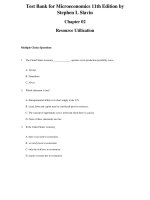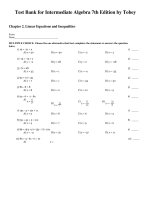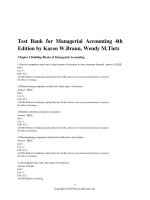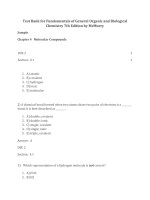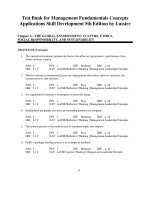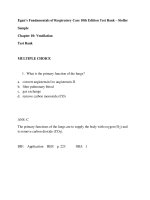link full download test bank for egans fundamentals of respiratory care 10th edition by stoller
Bạn đang xem bản rút gọn của tài liệu. Xem và tải ngay bản đầy đủ của tài liệu tại đây (408.41 KB, 50 trang )
Egan’s Fundamentals of Respiratory Care 10th Edition Test Bank – Stoller
Sample
Chapter 10: Ventilation
Test Bank
MULTIPLE CHOICE
1. What is the primary function of the lungs?
a.
b.
c.
d.
convert angiotensin I to angiotensin II
filter pulmonary blood
gas exchange
remove carbon monoxide (CO)
ANS: C
The primary functions of the lungs are to supply the body with oxygen (O2) and
to remove carbon dioxide (CO2).
DIF: Application
REF: p. 223
OBJ: 1
2. During each cycle of normal resting ventilation, a volume of gas is moved
into and out of the respiratory tract. This cyclical volume is called the:
a.
b.
c.
d.
inspiratory reserve volume (IRV)
vital capacity (VC)
residual volume (RV)
tidal volume (VT)
ANS: D
During each cycle, a volume of gas moves in and out of the respiratory tract.
This volume, measured during either inspiration or expiration, is called the tidal
volume, or VT.
DIF: Application
REF: p. 224
OBJ: 1
3. Which of the following pressures vary throughout the normal
breathing cycle?
4. alveolar pressure (Palv)
5. body surface pressure (Pbs)
6. mouth pressure (Pao)
7. pleural pressure (Ppl)
a.
b.
c.
d.
1, 2, 3, and 4
2, 3, and 4
2 and 4
1 and 4
ANS: D
Alveolar pressure (Palv), often referred to as intrapulmonary pressure, varies
during the breathing cycle. Ppl also varies during the breathing cycle.
DIF: Application
REF: p. 225
OBJ: 2
4. Which of the following pressures normally remains negative (relative to
atmospheric pressure) during quiet breathing?
a.
b.
c.
d.
Palv
Ppl
Pao
Pbs
ANS: B
Pleural pressure (Ppl) is usually negative (i.e., subatmospheric) during
quiet breathing.
DIF: Application
REF: p. 225
OBJ: 2
5. Which of the following pressure gradients is responsible for the actual flow
of gas into and out of the lungs during breathing?
a. transcanadian pressure gradient (Ppc – Pks)
b. transpulmonary pressure gradient (Palv – Ppl)
c. transrespiratory pressure gradient (Palv – Pao)
d. transthoracic pressure gradient (Ppl – Pbs)
ANS: C
The transrespiratory pressure gradient causes gas to flow into and out of the
alveoli during breathing.
DIF: Application
REF: p. 225
OBJ: 2
6. Which of the following pressure gradients is responsible for
maintaining alveolar inflation?
a.
b.
c.
d.
transpulmonary pressure gradient (Palv – Ppl)
transthoracic pressure gradient (Ppl –Pbs)
transcanadian pressure gradient (Pca – Pks)
transrespiratory pressure gradient (Palv – Pao)
ANS: A
Transpulmonary or PL is the pressure difference that maintains alveolar inflation.
DIF: Application
REF: p. 225
OBJ: 2
7. Which of the following statements about alveolar pressure (Palv)
during normal quiet breathing is true?
a.
b.
c.
d.
It is positive during inspiration and negative during expiration.
It is the same as intrapleural pressure (Ppl).
It is negative during inspiration and positive during expiration.
It always remains less than atmospheric pressure.
ANS: C
During inspiration the pleural pressure drops, the transpulmonary pressure gradient
widens, causing the alveoli pressure to become subatmospheric and gas to enter the
lung. During expiration the passive recoil of the lungs cause a supra-atmospheric
pressure in the alveoli that causes gas to exit the lung.
DIF: Application
REF: p. 225
OBJ: 2
8. What happens during normal inspiration?
9. The Ppl decreases further below atmospheric.
10.The transpulmonary pressure gradient widens.
11.Palv drops below that at the airway opening.
a.
b.
c.
d.
1, 2, and 3
2 and 3
1 only
1 and 3
ANS: A
As the alveoli expand, their pressures fall below the pressure at the airway opening.
This “negative” (i.e., subatmospheric) transrespiratory pressure gradient causes air
to flow from the airway opening to the alveoli, increasing their volume.
DIF: Application
REF: p. 226
OBJ: 2
9. During normal tidal ventilation, the transpulmonary pressure gradient (Palv
– Ppl) reaches its maximum value at what point in the cycle?
a.
b.
c.
d.
mid-inspiration
end-expiration
end-inspiration
mid-expiration
ANS: C
At this point, called end-inspiration, alveolar pressure has returned to 0 and the
transpulmonary pressure gradient reaches its maximal value (for a normal
breath) of approximately –10 cm H2O.
DIF: Application
REF: p. 225
OBJ: 3
10. During expiration, why does gas flow out from the lungs to the atmosphere?
a.
b.
c.
d.
Palv is less than at the airway opening.
Palv is the same as at the airway opening.
Palv is greater than at the airway opening.
Airway pressure is greater than Palv.
ANS: C
As expiration begins, the thorax recoils and Ppl starts to rise. As pleural
pressure rises, alveolar pressure also increases. The transpulmonary pressure
gradient narrows and alveoli begin to deflate. As the alveoli become smaller,
alveolar pressure exceeds that at the airway opening.
DIF: Application
REF: p. 226
OBJ: 2
11. What forces must be overcome to move air into the respiratory system?
12. tissue movement
13. elastic forces of lung tissue
14. airway resistance
15. surface tension forces
a.
b.
c.
d.
1, 2, and 3
2 and 4
4 only
1, 2, 3, and 4
ANS: D
Elastic forces involve the tissues of the lungs and thorax, along with surface
tension in the alveoli. Frictional forces include resistance caused by gas flow and
tissue movement during breathing.
DIF: Application
REF: p. 226
OBJ: 3
12. What term is used to note the difference between inspiratory lung
volume and expiratory lung volume at any given pressure?
a.
b.
c.
d.
alveolar aphasia
hysteresis
pleural pressure variance
transpulmonary pressures
ANS: B
Deflation of the lung does not follow the inflation curve exactly. During deflation,
lung volume at any given pressure is slightly greater than it is during inflation.
This difference between the inflation and deflation curves is called hysteresis.
DIF: Recall
REF: p. 227
OBJ: 3
13. What is the effect of surface tension forces in the air-filled lung?
14. It increases the elastic recoil of the lung (promoting collapse).
15. It makes the lung harder to inflate than if it were filled with fluid.
16. It decreases the lung’s elasticity as volume increases.
a.
b.
c.
d.
1 and 2
2
1 and 3
1, 2, and 3
ANS: A
Less pressure is needed to inflate a fluid-filled lung to a given volume. This
phenomenon indicates that a gas-fluid interface in the air-filled lung changes its
inflation-deflation characteristics. The recoil of the lung is therefore a
combination of tissue elasticity and these surface tension forces in the alveoli.
During inflation, additional pressure is needed to overcome surface tension forces.
DIF: Application
REF: p. 228
OBJ: 4
14. The presence of surfactant in the alveoli tends to do which of the following?
a.
b.
c.
d.
decrease compliance
decrease surface tension
increase elastance
increase resistance
ANS: B
A phospholipid called pulmonary surfactant lowers surface tension in the lung.
DIF: Application
REF: p. 228
15. How is compliance computed?
a. change in pressure/change in flow
b. change in pressure/change in volume
c. change in volume/change in flow
OBJ: 4
d. change in volume/change in pressure
ANS: D
Compliance of the lung (CL) is defined as volume change per unit of pressure
change. It is usually measured in liters per centimeter of water, as follows:
DIF: Application
REF: p. 228
OBJ: 5
16. Normal lung compliance is approximately which of the following?
a.
b.
c.
d.
0.01 L/cm H2O
0.20 L/cm H2O
2.00 L/cm H2O
10.00 L/cm H2O
ANS: B
Compliance of a healthy adult lung averages 0.2 L/cm H2O or 200 ml/cm H2O.
DIF: Recall
REF: p. 229
OBJ: 5
17. A lung that loses elastic fibers (as in emphysema) would exhibit which
of the following characteristics?
a.
b.
c.
d.
decreased airways resistance
decreased pulmonary vascular resistance
increased airway resistance
increased pulmonary compliance
ANS: D
Increased compliance results primarily from loss of elastic fibers, which occurs
in emphysema.
DIF: Application
REF: p. 229
OBJ: 5
18. A fibrotic lung would exhibit which of the following characteristics?
a.
b.
c.
d.
decreased airway resistance
decreased lung compliance
decreased PVR
decreased surface tension
ANS: B
The compliance curve of the patient with pulmonary fibrosis is flatter than the
normal curve, shifted down and to the right. As a result, there is a smaller
volume changes for any given pressure change (decreased compliance).
DIF: Application
REF: p. 229
OBJ: 5
19. What occurs at a lung volume equivalent to the functional residual
capacity (FRC)?
20. The forces of the chest wall and lungs are in balance.
21. Chest wall expansion is offset by lung contraction.
22. Opposing chest-wall-lung forces generate negative Ppl.
a.
b.
c.
d.
1, 2, and 3
1 and 2
1 and 3
2 and 3
ANS: A
The lung–chest wall system may be compared with two springs pulling against
each other. The chest wall spring tends to expand, whereas the lung spring tends
to contract. At the resting level, the forces of the chest wall and lungs balance. The
tendency of the chest wall to expand is offset by the contractile force of the lungs.
This balance of forces determines the resting lung volume, or FRC. The opposing
forces between the chest wall and lungs are partially responsible for the
subatmospheric pressure in the intrapleural space.
DIF: Application
REF: p. 225
OBJ: 4
20. At approximately what point during a maximum inspiration does the
chest wall reach its natural resting level?
a.
b.
c.
d.
about 30% of the VC
about 40% of the total lung capacity (TLC)
about 70% of the VC
about 90% of the VC
ANS: C
When lung volume nears 70% of the VC, the chest wall reaches its natural
resting level.
DIF: Application
REF: p. 230
OBJ: 4
21. Exhalation below the resting level requires active muscular effort in order
to overcome what tendency?
a.
b.
c.
d.
the airways to collapse
the alveoli to expand
the chest wall to expand
the lungs to expand
ANS: C
In order to exhale below the resting level (FRC) muscular effort is required to
overcome the tendency of the chest wall to expand.
DIF: Application
REF: p. 230
OBJ: 4
22. In order to inspire to a lung volume greater than about 70% of TLC,
the inspiratory muscles must overcome:
a.
b.
c.
d.
the recoil of the lungs
the recoil of both the lungs and the chest wall
the recoil of both the chest wall
the recoil of the alveoli
ANS: B
At the beginning of the breath, the tendency of the chest wall to expand facilitates
lung expansion. When lung volume nears 70% of the VC, the chest wall reaches
its natural resting level. In order to inspire to a lung volume greater than about
70% of TLC, the inspiratory muscles must overcome the recoil of both the lungs
and the chest wall (see Figure 10-7).
DIF: Analysis
REF: p. 230
OBJ: 5
23. Total lung–thorax compliance in normal subjects is about what level?
a.
b.
c.
d.
0.1 L/cm H2O
0.2 L/cm H2O
1.0 L/cm H2O
2.0 L/cm H2O
ANS: A
In healthy adults, the compliance of the lungs and chest wall are approximately
equal at 0.2 L/cm H2O. However, because the lungs are contained within the
thorax, the two systems act as springs pulling against each other. This reduces the
compliance of the system to approximately half that of the individual components,
or 0.1 L/cm H2O.
Impedance to ventilation by the movement of gas through the airways is
called airway resistance.
DIF: Application
REF: p. 230
OBJ: 5
24. What is the term for the impedance to ventilation caused by the
movement of gas through the conducting system of the lungs?
a.
b.
c.
d.
airway resistance
lung compliance
surface tension
tissue elastance
ANS: A
DIF:
Application REF: p. 231
25. How is airway resistance (Raw) computed?
a.
b.
c.
d.
change in pressure/change in volume
change in pressure/flow
change in volume change in pressure
change in volume/change in pressure
ANS: B
OBJ: 6
Airway resistance (Raw) is the ratio of driving pressure responsible for
gas movement to the flow of the gas (), calculated as follows:
DIF: Application
REF: p. 231
OBJ: 6
26. Normal Raw is approximately which of the following?
a.
b.
c.
d.
0.1 to 0.2 cm H2O/L/sec
0.5 to 2.5 cm H2O/L/sec
15.0 to 20.0 cm H2O/L/sec
20.0 to 25.0 cm H2O/L/sec
ANS: B
Airway resistance in healthy adults ranges from approximately 0.5 to 2.5 cm
H2O/L/sec.
DIF: Application
REF: p. 231
OBJ: 6
27. Which of the following factors affects Raw?
28. pattern of gas flow (e.g., laminar versus turbulent)
29. characteristics of the gas being breathed
30. diameter and length of the airways
31. variations in lung compliance
a. 1, 2, and 3
b. 2 and 4
c. 4 only
d. 1, 2, 3, and 4
ANS: A
Laminar flow is affected by gas flow, viscosity of the gas, tube radius and
length. Turbulent flow is most affected by gas density and viscosity, linear
velocity and tube radius.
DIF: Application
REF: p. 231
OBJ: 6
28. According to Poiseuille’s law, which of the following statements are true
if we wish to maintain a constant flow of gases?
a. Alveolar recruitment has its greatest effect on flow.
the tube radius will require a 16-time increase in driving
b. Halving
pressure.
jumps in driving pressure are needed to overcome airway
c. Large
narrowing.
d. The driving pressure varies directly with the airway circumference.
ANS: B
For gas flow to remain constant, delivery pressure must vary inversely with the
fourth power of the airway’s radius. Reducing the radius of a tube by half requires
a 16-fold pressure increase to maintain a constant flow. To maintain ventilation in
the presence of narrowing airways, large increases in driving pressure may be
needed. The energy necessary to generate these pressures can markedly increase
the work of breathing.
DIF: Application
REF: p. 231
OBJ: 6
29. Most of the drop in pressure due to frictional resistance to gas flow occurs
in what region?
a.
b.
c.
d.
nose, mouth, and large airways
respiratory bronchioles
terminal bronchioles
terminal respiratory unit
ANS: A
Approximately 80% of the resistance to gas flow occurs in the nose, mouth,
and large airways where flow is mainly turbulent.
DIF: Application
REF: p. 231
OBJ: 6
30. Which of the following statements about Raw is true?
a.
b.
c.
d.
The greater the lung volume, the greater is the Raw.
The greater the lung volume, the less is the Raw.
As lung volume decreases toward RV, the Raw drops.
As lung volume increases toward TLC, the Raw rises.
ANS: B
The increase in airway diameter with increasing lung volume decreases airway
resistance.
DIF: Application
REF: p. 234
OBJ: 6
31. In healthy individuals, what may lead to airway collapse?
a.
b.
c.
d.
increased lung recoil
significantly decreased surfactant
maximal inspiration to TLC
forced exhalation to RV
ANS: D
In airways of healthy subjects, airway collapse occurs only with forced
exhalation and at low lung volumes.
DIF: Application
REF: p. 236
OBJ: 6
32. Which of the following statements about the equal pressure point (EPP)
is true?
gas travels from the EPP to the mouth, greater expiratory effort
a. As
increases flow.
b. At the EPP, pressure inside the airway exceeds Ppl.
c. The EPP normally occurs at volumes greatly below the FRC.
d.
Upstreamairway. from the EPP (toward the alveoli), Ppl exceeds pressure in the
ANS: C
At some point along the airway, the pressure inside equals the pressure outside in
the pleural space. This point is referred to as the EPP. Downstream from this
point, pleural pressure exceeds the airway pressure. The resulting positive
transmural pressure gradient causes airway compression and can lead to actual
collapse. Airway compression increases expiratory airway resistance and limits
flow. At the EPP, greater expiratory effort only increases pleural pressure, further
restricting flow. In airways of healthy subjects, the EPP occurs only with forced
exhalation and at low lung volumes.
DIF: Application
REF: p. 236
OBJ: 6
33. For healthy individuals at rest, which of the following statements
about exhalation is true?
a. Exhalation will be passive, due to inspiratory stored potential energy.
b.
Exhalationinspiration. will only require 40% of the energy expended for
c. Exhalation will be the result of accessory respiratory muscle use.
d. Exhalation will generally take half the time of inspiration.
ANS: A
During normal quiet breathing, inhalation is active and exhalation is passive. The
work of exhaling is recovered from potential energy “stored” in the expanded
lung and thorax during inhalation.
DIF: Application
REF: p. 237
OBJ: 7
34. In traditional physical terms, how is work defined?
a.
b.
c.
d.
force ´ distance
force ´ time
mass ´ acceleration
mass ´ force
ANS: A
Work = force ´ distance.
DIF: Application
REF: p. 237
OBJ: 7
35. Which of the following formulas is used to compute the mechanical work
of breathing?
a.
b.
c.
d.
change in pressure/flow
change in pressure ´ change in flow
change in pressure ´ change in volume
change in volume/change in pressure
ANS: C
The mechanical work of breathing can be calculated as the product of the pressure
across the respiratory system and the resulting change in volume:
DIF: Application
REF: p. 237
OBJ: 7
36. Why is the total mechanical work of breathing difficult to assess
during spontaneous breathing?
a.
b.
c.
d.
Most volunteer subjects cannot understand the procedure used.
Respiratory muscle activity contributes to inflation resistance.
The respiratory muscles (diaphragm, etc.) must be paralyzed.
The subjects used to make the measurements must be unconscious.
ANS: B
The mechanical work of breathing cannot be measured easily during
spontaneous breathing. This is because the respiratory muscles contribute to the
resistance offered by the chest wall.
DIF: Application
REF: p. 238
OBJ: 7
37. On inspecting a volume–pressure curve of the lungs and thorax, an
increase in the mechanical work of breathing above normal would always
be indicated by which of the following?
a.
b.
c.
d.
decrease in the area of the volume–pressure curve
decrease in the slope of the volume–pressure curve
increase in the area of the volume–pressure curve
Increase in the slope of the volume–pressure curve
ANS: C
The larger the area defined by the pressure and volume changes, the greater is the
amount of work being done.
DIF: Application
REF: p. 238
OBJ: 7
38. In health, about what proportion of the total work of breathing is
attributable to frictional resistance to gas and tissue movement?
a.
b.
c.
d.
ANS: A
In healthy adults, approximately two thirds of the work of breathing can be
attributed to elastic forces opposing ventilation. The remaining third is a result of
frictional resistance to gas and tissue movement.
DIF: Application
REF: p. 238
OBJ: 7
39. On inspecting a volume–pressure curve for a patient with restrictive lung
disease, which of the following abnormalities would you expect to find?
40. decrease in the slope of the volume–pressure curve
41. increase in the area of the volume–pressure curve
42. positive Ppl during exhalation
a.
b.
c.
d.
2 only
1, 2, and 3
1 and 2
1 and 3
ANS: C
In restrictive lung disease, the area of the volume–pressure curve is greater because
the slope of the static component (compliance) is less than normal.
DIF: Application
REF: p. 238
OBJ: 7
40. Which of the following factors would tend to increase the elastic
component of the work of breathing?
41. decreased compliance of the lungs or thorax
42. high frequencies of breathing
43. increased VT
a.
b.
c.
d.
1 and 3
1, 2, and 3
2 and 3
1 and 2
ANS: A
When changing from quiet breathing to exercise ventilation, healthy subjects adjust
their tidal volumes and breathing frequencies to minimize the work of breathing.
Similar adjustments occur in individuals who have lung disease (Figure 10-12).
Patients with “stiff lungs”, i.e. decreased compliance, have increased elastic work
of breathing. Large tidal volumes also increase the elastic component of work.
DIF: Application
REF: p. 245
OBJ: 7
41. Which of the following factors would tend to increase the
frictional component of the work of breathing?
42. decreased compliance of the lungs or thorax
43. high frequencies of breathing
44. increased Raw
a.
b.
c.
d.
1 and 2
1, 2, and 3
1 and 3
2 and 3
ANS: D
In healthy individuals, the mechanical work of breathing depends on the pattern
of ventilation. High breathing rates (and hence, high flows) increase frictional
work. Patients who have airway obstruction (i.e., increased Raw) also experience
increased frictional work of breathing.
